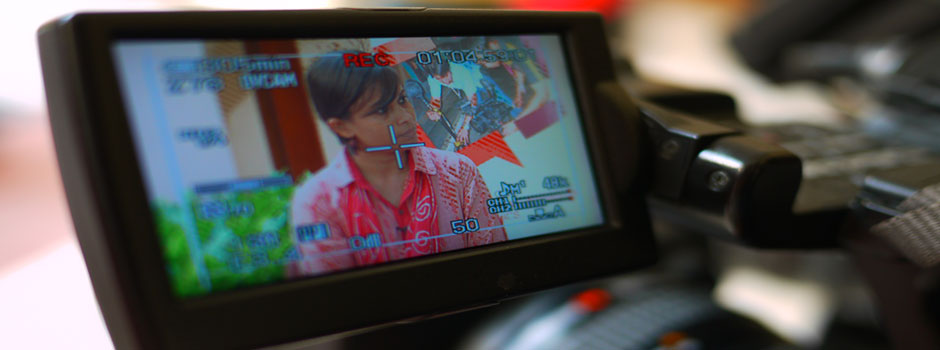Shots meaning
Every time the cameraman starts his camera, films and stops, he’s making a shot. The shots filmed in a same place or around the event are called a sequence, a family of shots that must be varied.
- The long shot helps define the general context.
- The extreme long shot locates the characters.
- Le medium long shot shows the characters in action.
- The close shot shows one or various characters in situ.
- The close up is a TV classic, it appeals to the way we see others naturally.
- The extreme close-up on a body detail or a precise act.
- The insert focuses the attention on a visual clue linked to the action being described.
Shooting styles and their effect.
- The opener :
A character or an object peak out from one side of the frame, which accentuates the depth.
- High angle and low angle shots :
The camera lens is looking up or looking down, which suggest dominance either of the viewer or the viewee.
- The sequence shot :
The camera doesn’t cut : the sequence is one long take. Without any interruption the camera follows the description of a location or the on-going action.
- Subjective camera :
The image becomes the sight of somebody involved in the action. It gives the viewer the impression of being right in on the action.
Camera moves.
- Pan shots :
The camera pivots on its axis, to show a context, to locate an event.
- Tracking shots :
The camera moves and follows a continuous trajectory, oftentimes parallel to the character, the object it’s filming. In reporting, tracking shots are filmed from a car, a train… They might indicate a process, a story, or an evolution.
Moves and optical effects.
- Zooming :
Objects standing afar are brought closer. For a package, the best way to zoom in is by getting closer to what you’re filming.
- Blurry/clear :
The cameraman makes a foreground element go from blurry to clear, or the reverse. It’s an effect that marks a transition with no clear cut.
- Fade to black (or white) :
It marks a clear cut. Used between two interview extracts it clearly shows the editing.
Shooting axes.
- The rule of three :
An action is described through at least three shots. These must have at least two ranks of difference in cinematographic distinctions so as to avoid “jumps”.
- The 180° rule :
Normally an action should never pass the invisible line separating the space in two. The scene shot starts making no sense if the camera doesn’t keep its point of view on either side of that line.
- Voice offs :
A frame depicts as much what is shown and what is suggested. A rearview mirror shows the whole car, a cufflink somebody…
4 pieces of advice :
- Move as little as possible : let the viewer get an idea of the scene.
- Work as often as possible with a tripod or a monopod : a stable image is a professional once, and therefore a believable one.
- Check the audio is fine with headsets : wild noises can disturb listening and/or understanding.
- Check that everything’s working before going on the field : batteries, flash cards, lightning…
How many shots should you bring back for the editor ?
A package= 20 or so edited shots = 60 filmed shots (that’s 3 to 1)
To get lively editing, you need to shoot :
- 6 long shots to get 2 edited
- 24 close shots to get 8 edited
- 30 close ups to get 10 edited
- 2 minutes interview to get 30 seconds edited.
The image answers the following questions : who ? what ? where ?
The location, the environnement, the space where the event is taking place as well as the characters, the people interviewed and the people concerned by the event.
When shooting the journalist and the cameraman define all questions that can’t be answered through the images or the audio. The commentary answers those abstract questions, such as Why? How?

